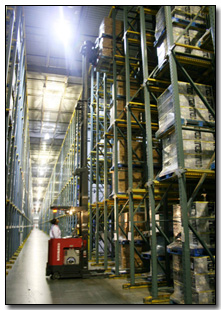Drive-In / Drive-Thru pallet warehouse racking systems are a cost-effective solution to high-density storage. This static system has rails running the depth of the rack for pallet placement. The only limitation to the depth of pallet storage is the capability to drive deep within the system. The rack depth reduces the need for aisles and drastically increases cubed space utilization. Drive-In warehouse racking systems load and retrieve from the same side, creating an organization of Last-In-First-Out (LIFO) inventory retrieval.
Warehouse racking systems are easy to install with simple support arms to hold rails and can be attached to standard pallet rack or special structural designs. UNARCO Engineering has specially designed sloped-leg frames to add extra clearance and safety for forklift movement within the aisles. This greatly reduces the risk of impact damage to front posts and allows drivers to swing loads as they exit the rack. Drive-In/Drive-Thru rack systems should be used for large volumes of like-product. Because of the high-density storage, the product is not easily accessible as pallets are stored floor to ceiling. However, dense storage can create space for up to seven times more product than floor stacking or three times more than pallet rack because pallets are stored back-to-back, floor-to-ceiling. Lift truck drivers never enter the rack. The first pallet rests on the top cart, and the second pallet pushes that pallet back to rest on the second cart. Additional pallets will rest on the nested carts below, and the final pallet rests on the sturdy structural steel rails. As pallets are removed, each position behind flows forward gently until all product is finally brought to rest by rubber bumpers at the front of the system. |



 Drive-Thru warehouse racking systems load from one side and unload from the other to create First-In-First-Out inventory retrieval.
Drive-Thru warehouse racking systems load from one side and unload from the other to create First-In-First-Out inventory retrieval. 
